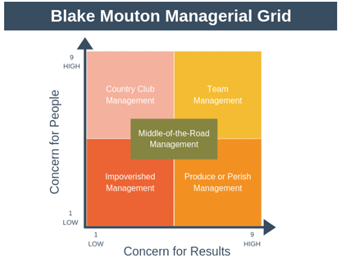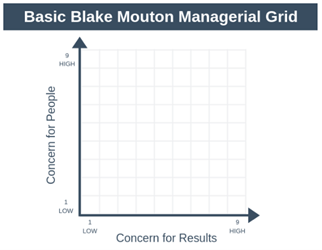The Blake-Mouton Managerial Grid
Contents |
Abstract
Leading various projects requires a good leader with a wide range of properties, within knowledge about project management as well as knowledge for dealing with different types of people. A good project manager is aware of what it takes to reach the milestones of a project and has the ability to get an overview of the resources, time and economy. It also requires a leader who can communicate with the employees and has a knowledge and understanding for them. Therefore, is the type of leadership an important topic, and the identification of the style can contribute to better project management and to better project results. As a project leader it is an advantage to address your own strengths and weaknesses, so you can become a better leader, but also know your own qualities. It provides an opportunity to be able to develop your abilities and optimize the competencies. In this context will the article be representing the management tool called “Blake-Mouton Managerial Grid”, which is a model developed by Robert R. Blake and Jane Mouton. The tool gives an impression and opportunity for managers to analyze their own leadership styles. The main points of the tool will be covered and a description on how to apply the “Blake-Mouton Managerial Grid” will be included. Moreover, will the Advantages and disadvantages of the tool be discussed.
Introduction
and Jane S. Mouton,. .The Blake Mouton grid is a matrix which characterizes five different leadership styles based on a two-behavioral dimensional graph. The Y-axis represents the leader behavior, “Concern for people” and the X-axis. represents the “Concern for results”. In the context of human concern, there are various leadership qualities that primarily are described as the manager´s interest in the employees´ motivation, well-being and needs, which can provide the work effort / performance. While the other interest for the manager is to complete the project with a focus on the production itself, the results, and the economy.
The two dimensions of leader behavior leads into 5 different management styles.
- Impoverished Management
- Produce or Perish Management
- Middle-of-the-Road Management
- Country Club Management
- Team Management
Team Management
This type of leader takes responsibility for the organization's goals and the development, motivation, and well-being of the employees. This method of management has benefits for both leaders and employees. From the employees' point of view, they are allowed to develop and learn from the mistakes they make. The project manager will be busy, but over time it will create some freedom for the manager, as the employees will be self-driving. The "Team management style." It is a coveted style of management among small and more significant companies.
How to use the tool
The grid is a two-dimensional Managerial Grid that characters a leader based on a manager´s concern for people and the production. The Y-axis in the coordinate system is standing for the focus of the employees/ concern for people and the x-axis is standing for the production/results. And each axis consists of a nine-point scale, where the lowest number means a low concern and the high number indicates a high concern. The first step is to complete a test with leadership questions, which are based on the topics concern for people and production. After that, you can see the score and which manager style you are matching.
Discussion
Advantages:
The Blake-Mouton grid provides a simple way to understand “Your” leadership style. And that makes it easier to takes steps to address your weaknesses, so you can develop and become a better leader.
Disadvantages:
The Blake-Mouton grid is overly simplistic, and the tool has a big focus on the leader and does not pay attention to other factors there may be. Therefore, is this type of leader analyzes limited, but it can provide a direction and create an overall picture of the leadership style.

